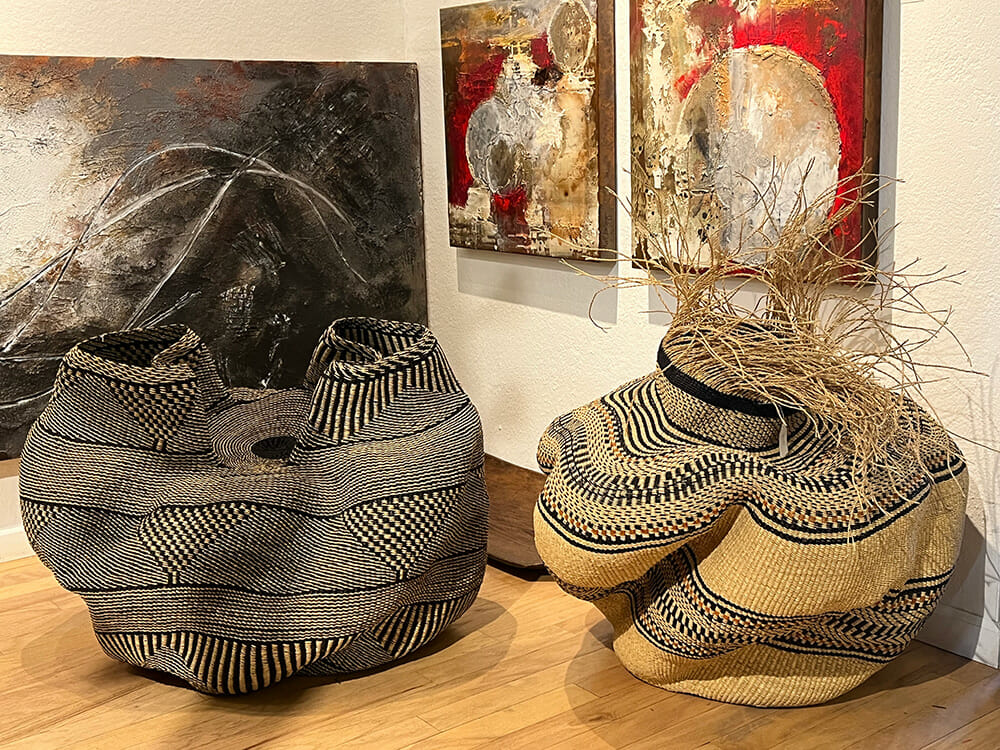Lucien Wolff believes that one’s surroundings should serve to elevate mind and spirit. With this mantra as a constant signpost, the Palm Desert–based gallerist and interior designer set out from a very young age to “spread the magical dust” and bring joy to strangers through his uniquely sophisticated — and well-traveled — creative vision.
Originally from South Africa, Wolff cites a lifelong love of artistry as the reason for his foray into art and design. He studied architecture at the University of Cape Town, then in 1979, moved to Los Angeles, where he practiced for five years. In the mid-’80s, an opportunity presented itself: A client asked if he was interested in taking over a gallery space at the iconic Century Plaza Hotel (now Fairmont Century Plaza), and Wolff made the jump to become an art curator.
To be sure, the aesthete’s inner child leaped at the chance to focus his professional journey on fine art. Wolff recalls painting as early as 4 years old. He remembers hosting his first exhibition when he was 6. “I invited all my mother’s friends. I typed out little invitations and sent it to all of them. I had this very primitive art. One or two bought them for, like, 5 cents.”
After 15 years operating the gallery in Los Angeles, this freethinker was ready for change. “Once my kids had finished college,” Wolff says, “I knew it was time for me to explore other places. So, I came to Palm Desert in 2000 and opened Desert Wolff at The Art Place Palm Desert [a complex of art and design stores].” Eventually, his namesake gallery morphed into a part-time interior design business, and now, Wolff does a bit of both — he’s grateful to have the platform to share his perspective with others in the community and the prospect to make art more attainable for patrons.
In 2019, Wolff relocated his gallery and showroom to El Paseo, drawn to the high-end tendencies of the street and the refined tastes of its foot-traffic and regular clientele. We caught up with Lucien recently to learn more about that “magical dust” and the experience and services available to customers of Desert Wolff. Here’s what he had to say.

Paintings by Stockstill and Ben Michal; Moroccan chest and porcelain urn; house posts from Mali.
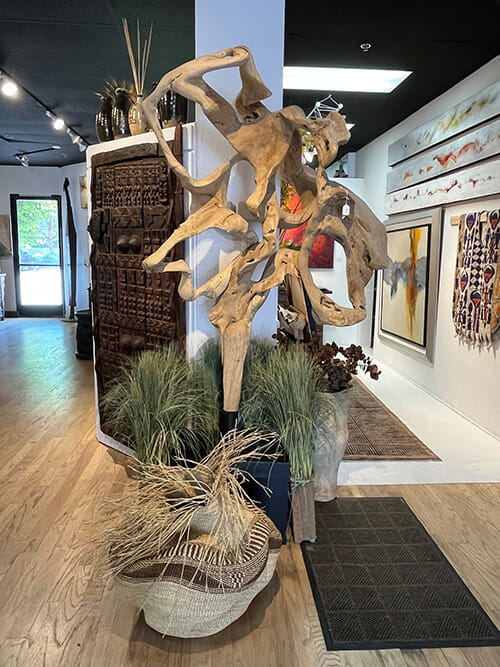
A granary door from Mali hangs behind a handcarved wooden sculpture and woven basket from Ghana.
When it comes to your design outlook, you have said that the home environment should serve to elevate one’s mind and spirit. What do you mean by that?
You need to get the “wow factor.”
You need to go, “Wow, what am I looking at? Is this thrilling me? Does it excite me? Am I interested in finding more? Can I explore this space?” [Guests are] complimenting the person who owns it: “Wow, you’ve got such good taste. Where did you get this?” There’s a sense of curiosity and inquisitiveness, hopefully, with what I do, and the reaction of people looking at it. A sense of inspiration, a sense of joy.
You offer a variety of artwork, sculptures, artifacts, and other decorative objects in the Desert Wolff showroom. Is there a bestseller, or something that you are particularly excited to have in store right now?
These baskets that I have from Ghana are a showstopper. They’re art baskets, not functional. They bring people in, and I sell two or three of them every single day. People have never seen anything like them before. They’re made from elephant grass, and they’re very textural. They have a lot of movement to them. They’re organic.
I have little ones that are about 12 or 15 inches tall, and the same in width. They are multicolor — greens and blues and oranges. And there are some that are just black and white, with no color at all. But most of them have African patterns. They’re made by a school of basket weavers in Ghana, in North Africa. It’s kind of exciting to know that we are creating work for people in that part of the world.
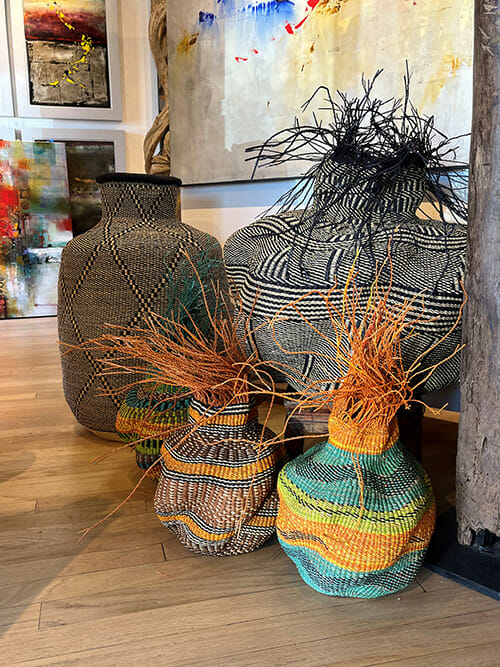
Elephant-grass baskets made by weavers in Ghana are a bestseller at Desert Wolff.
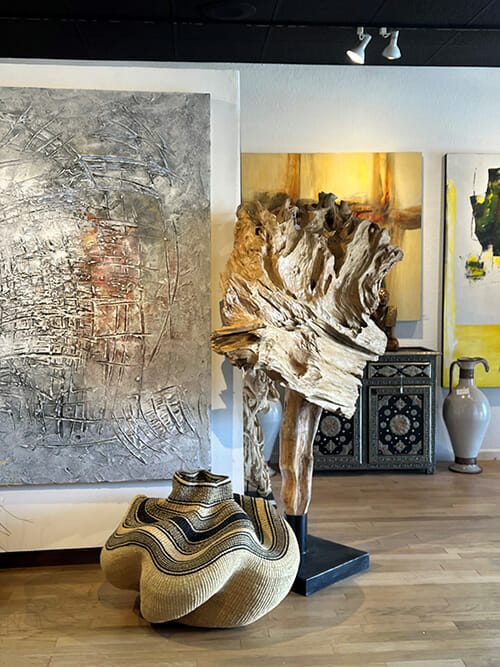
An organic wooden sculpture and Ghanaian basket stand in front of a heavily textured painting by Ben Michal.
What do you love most about what you do?
I really enjoy the buying of all the arts and artifacts. I spend a lot of time on it. I look at it in detail. I look at the quality of things. I look at the size. The scale is critical in what I purchase and in how I furnish people’s homes. I deal mainly with large-scale art, because the houses out here call for that — [especially] in clubs like Bighorn, Vintage, Reserve, and so forth. I love buying the art. I love displaying it here in the gallery. And I love selling it, because the people who buy it somehow get it.
Even if they come from a different perspective, I’m able to show them a different way of looking at art. A lot of people don’t know what it is that they want, and that’s why they come to me — because I have a professional eye. I love to change the look of spaces, and through what I do, make a huge difference to the ambience in the house, a difference to the reaction that the clients get, just making the spaces look exciting and luxurious and interesting.
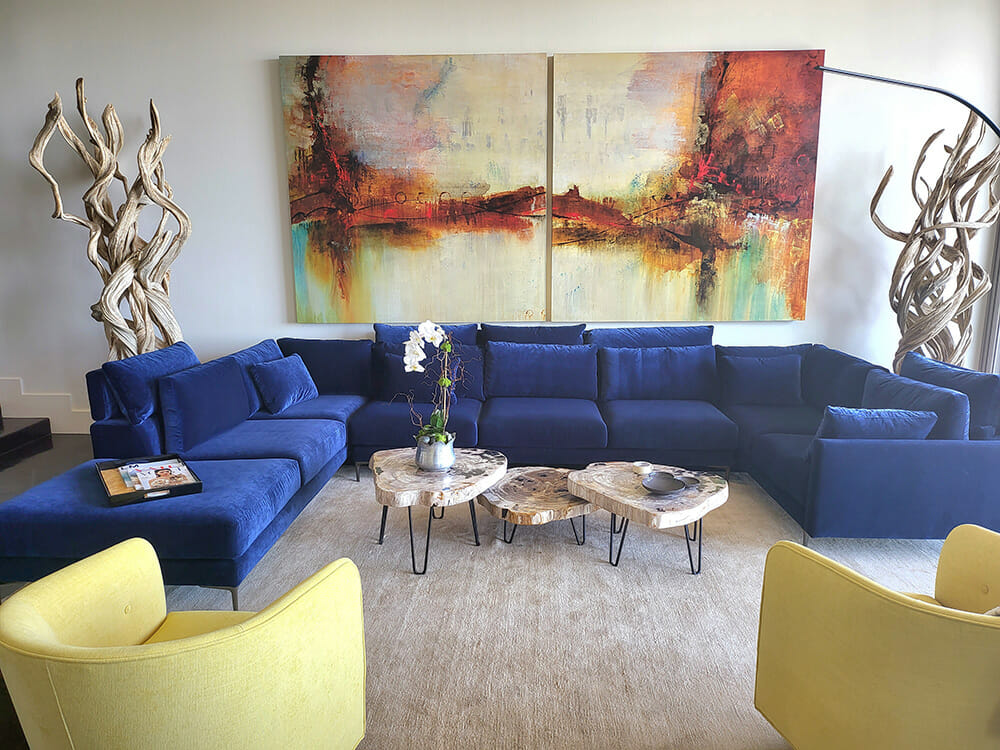
A Bighorn Golf Club home, where Lucien Wolff recently completed the interior design, provided the perfect canvas for a selection of large-scale art, including this diptych by artist Cohen Gray, hanging above the Cantoni sectional. A pair of Southeast Asian vine sculptures flanking the sofa complement petrified wood coffee tables. A Cantoni floor lamp and Shiraz wool rug complete the space. (All items sourced from Desert Wolff.)
Does your background in architecture influence your approach to interior design projects?
I’m able to create new spaces — a different environment — pushing walls out, moving fireplaces, creating different niches and putting different materials on walls, dealing with lighting. All that kind of stuff is architecturally related.
What do you think about the architecture in Greater Palm Springs?
I really, really love it, specifically here in Palm Desert. The architecture in Bighorn is spectacular. I love the massive walls. I love the huge, glass windows [and] how that brings the landscape inside. I love the views. I love the spaciousness.
How does that play well with the artwork and design elements that you bring into a space?
Well, what shall I say? My art sings. My art is large, and it works in harmony with the large spaces and the desert architecture and the views. And that’s exciting to me.
I don’t do strict midcentury because I find it actually a little boring. The kind of work that I do is timeless, and hopefully withstands changing fads, changing colors, changing seasons, whatever is currently in vogue. It’s all classic. It’s all contemporary, and it’s great to mix everything into it.
What drew you to your current location on El Paseo?
El Paseo is like Rodeo Drive — I like the sophistication of the street. A lot of the merchants get to know each other because we send business to one another. It’s a close community, and it’s a fun shopping experience for anyone coming to the desert. I find we have tons of out-of-towners who just like to walk up and down the street. It’s marvelous. I love it, and so does everyone else who comes in here.
For more information about Desert Wolff, including the company’s interior design services, visit desertwolff.com or stop by the showroom and gallery on El Paseo.

